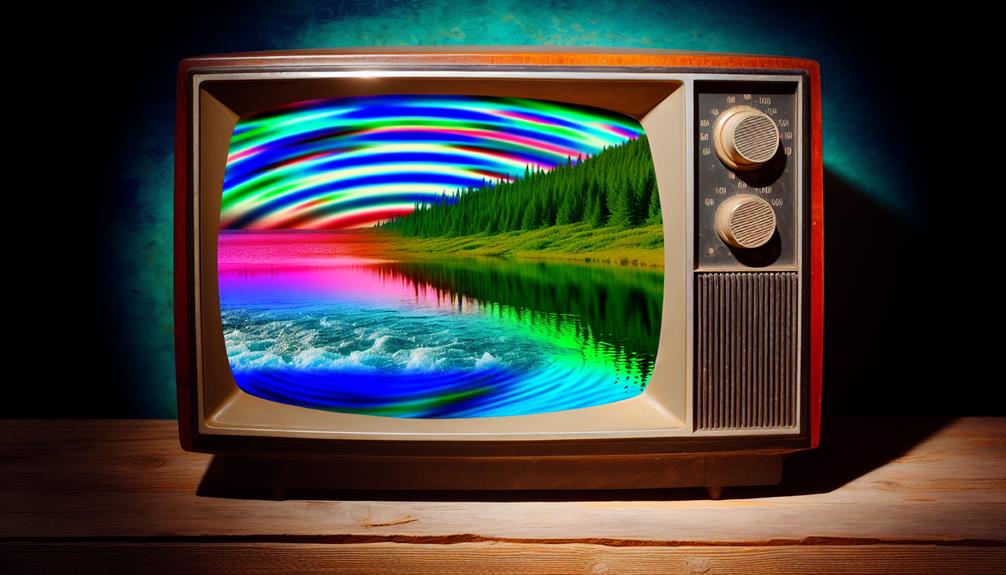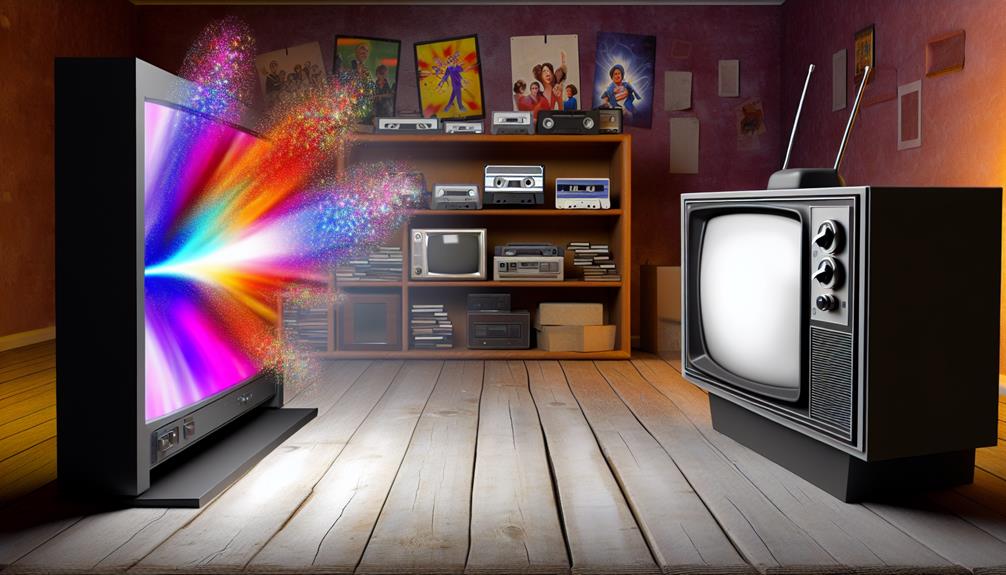Modern televisions no longer display static and white noise due to the change from analog to digital broadcasting. Digital signals offer greatly improved quality by minimizing interference and enhancing clarity. Advances in signal processing and compression technologies further guarantee a seamless viewer experience by optimizing bandwidth and providing more channels. As cable and streaming services gain popularity, viewer expectations have shifted towards high-quality content without interruptions. This evolution in broadcasting not only enhances viewer engagement but also reshapes consumption habits. Exploring the implications of this alteration reveals deeper insights into the future of television technology and viewer experiences.
Key Takeaways
- Digital broadcasting replaced analog signals, significantly reducing static and white noise in television reception.
- Enhanced signal processing techniques improve audio-visual clarity, minimizing interference commonly seen in analog formats.
- Digital compression optimizes bandwidth, allowing for clearer transmission and eliminating unwanted noise during broadcasts.
- Modern TVs are designed to connect to various streaming services, which provide high-quality content devoid of static interruptions.
- The shift towards on-demand, high-resolution content aligns with viewer expectations for seamless and engaging media experiences.
The Transition From Analog to Digital

The shift from analog to digital broadcasting has fundamentally transformed the way television signals are transmitted and received, marking a significant evolution in the media landscape. This change mirrors other technological advancements, such as changes in current exchange rates, which also impact how we engage with the world. Analog signals were susceptible to various forms of signal interference, leading to static images and poor viewer experiences. The advent of the digital era introduced advanced transmission technology that enhances signal integrity, resulting in improved clarity and a reduction in noise. Digital broadcasting employs compression techniques that minimize distortion and optimize bandwidth, allowing for multiple channels within the same frequency spectrum. Consequently, viewers now enjoy a more reliable and immersive experience, devoid of the static and white noise characteristic of earlier broadcasts. This evolution has not only elevated content quality but also reinforced the community's connection to media.
Changes in Broadcasting Standards
The shift from analog to digital broadcasting has greatly transformed the landscape of television reception and signal quality. This change has not only eliminated the presence of static and white noise but has also introduced higher resolution and clearer audio-visual experiences for viewers. As technology continues to advance, viewers now enjoy a more immersive experience, similar to how a triple-monitor setup can enhance productivity through optimized screen real estate for multitasking. Consequently, these changes in broadcasting standards have played a pivotal role in enhancing overall content delivery and viewer satisfaction.
Digital Transition Impact
Shifting to digital broadcasting has fundamentally reshaped the landscape of television viewing, eliminating the once-familiar phenomena of static and white noise. This change, driven by digital innovation, has enhanced viewer engagement and expanded the possibilities of content delivery.
- Seamless streaming of high-definition content
- Interactive features that personalize the viewing experience
- A diverse array of channels accessible at the touch of a button
As traditional analog signals fade into history, the advantages of digital platforms become increasingly evident. The precision of digital signals reduces interference, providing clearer audio and visual experiences. Additionally, the shift facilitates advancements in multimedia content, fostering deeper connections between networks and audiences, ultimately transforming the way viewers consume media.
Signal Quality Improvements
Advancements in broadcasting standards have greatly enhanced signal quality, leading to a more reliable and immersive viewing experience. Modern signal processing techniques have considerably improved noise reduction, minimizing signal interference that once plagued analog transmissions. Enhanced transmission technology allows for better broadcast clarity, ensuring that viewers receive high-quality images without the distracting static of the past. Additionally, sophisticated image compression methods enable efficient data handling, allowing for more channels and better utilization of bandwidth. The evolution of reception methods, including the shift to digital antennas, further strengthens signal integrity. Collectively, these improvements contribute to a seamless viewing experience, fostering a sense of belonging among audiences who now enjoy consistent, high-definition programming without the interruptions of static and white noise.
Rise of Cable and Streaming Services

The change from analog to digital broadcasting has fundamentally altered television consumption, rendering traditional static and white noise obsolete. This transformation has been fueled by the increasing popularity of cable and streaming services, which allow viewers to enjoy content on demand, without the interruptions and limitations of older technologies. As viewers seek more personalized viewing experiences, the rise of trending products and services in the streaming market showcases how consumer preferences are shaping the future of media. As cable and streaming services gain prominence, viewers now have access to a vast array of content without the interruptions previously associated with analog signals. This shift not only enhances user experience but also reflects broader changes in media distribution and consumption patterns.
Shift to Digital Broadcasting
With the shift from analog to digital broadcasting, the landscape of television viewing has undergone a profound transformation. This evolution has enhanced the viewer experience, offering superior picture and sound quality. Key technological advancements include:
- Digital Compression: Optimizing bandwidth usage, allowing more channels in less space.
- Signal Modulation: Enabling clearer transmission and reception, reducing interference.
- Increased Accessibility: Making a wider range of content available to audiences.
These innovations have rendered static and white noise obsolete, as digital signals provide consistent clarity. Additionally, the change to digital broadcasting has played a vital role in the rise of cable and streaming services, fostering a sense of belonging among viewers who now enjoy diverse programming options tailored to their preferences.
Impact of Streaming Services
A significant shift in viewer habits has emerged due to the proliferation of streaming services, fundamentally altering the television landscape. This streaming evolution has enhanced content accessibility, allowing viewers to access a vast array of programming anytime, anywhere. Traditional cable models, characterized by fixed schedules and limited choices, have been challenged as audiences increasingly favor on-demand viewing experiences. The rise of platforms such as Netflix, Hulu, and Disney+ has not only diversified content offerings but also fostered a sense of community among viewers who engage with shared interests in series and films. Consequently, the expectation for instantaneous access to diverse content has reshaped production standards, compelling creators to prioritize quality and innovation, further solidifying streaming services' pivotal role in modern entertainment consumption.
Enhanced Signal Quality
Improving signal transmission has markedly diminished the prevalence of static and white noise on modern televisions. This transformation is largely attributed to advancements in signal enhancement technologies and improved broadcast clarity, making the viewing experience as refined as the elegance of a black lace jumpsuit. These innovations have enabled viewers to experience a more seamless engagement with content, fostering a sense of community among audiences who appreciate high-quality visuals and sound.
- Enhanced algorithms for signal processing
- High-definition broadcast formats
- Advanced error correction techniques
Together, these elements contribute to a more stable and reliable viewing experience. As a result, the elimination of static and white noise not only enhances the enjoyment of media but also reinforces a collective appreciation for the technical progress that has transformed television into a polished and immersive medium.
Viewer Preferences and Habits

The evolution of signal quality has not only transformed the technical aspects of television but also greatly influenced viewer preferences and habits. As media accessibility improved, so did viewer engagement, leading to significant shifts in content consumption patterns. Enhanced technology adoption has resulted in diverse devices integrating seamlessly with television, reshaping audience behavior and entertainment preferences. Viewers now exhibit more selective viewing patterns, often curating content tailored to their interests, which reflects the growing need for rewarding career paths in the media industry as people seek fulfilling roles. This shift underscores an increasing demand for personalized experiences, where static images and white noise are no longer tolerated. Consequently, the modern viewer expects uninterrupted, high-quality content, reflecting a broader trend in the media landscape towards convenience and immediacy in their entertainment choices.
Future of Television Technology
Significant advancements in television technology are poised to redefine the viewing experience over the next decade. As we move forward, several key innovations will shape the landscape:
- Immersive experiences that transport viewers into the narrative.
- Interactive content that fosters real-time user engagement.
- Augmented reality that blends digital elements with the physical world.
These future innovations will leverage smart technology and advanced interfaces to deliver content personalization tailored to individual preferences. Viewers will no longer passively consume media; instead, they will actively participate in their entertainment journeys. This evolution promises to create a more connected community, where shared experiences enhance belonging and engagement, ultimately transforming television into a dynamic platform that resonates with diverse audiences and lifestyles.
Frequently Asked Questions
What Is Static and White Noise in Television Broadcasts?
Static and white noise in television broadcasts refer to the visual and auditory disruptions caused by signal interference, typically arising from weak or absent signals. In the context of broadcast technology, static manifests as random patterns on the screen while white noise presents as a hissing sound. These phenomena were prevalent in earlier television systems, reflecting the limitations of transmission quality and equipment. Advances in digital broadcasting have greatly reduced such disruptions, enhancing viewer experience.
How Did Analog Signals Create Static and White Noise?
Analog transmission relied on continuous signals, which were vulnerable to signal interference from various sources like electrical devices or atmospheric conditions. This interference disrupted the clarity of the transmitted signal, resulting in static and white noise on televisions. The inherent limitations of analog technology meant that any degradation in signal quality directly impacted the viewer's experience, manifesting as visual artifacts and auditory disturbances, ultimately leading to a less satisfactory reception of broadcast content.
Are There Any Devices That Still Use Analog Signals?
Despite the predominance of digital technology, several devices still utilize analog signals, particularly within the domain of vintage technology. Examples include turntables, cassette players, and certain radio receivers that continue to operate on analog principles. These analog signal devices evoke nostalgia and maintain a dedicated following among enthusiasts who appreciate their unique sound qualities and tactile experiences. The enduring appeal of such technology underscores a desire for authenticity in an increasingly digital world.
Can Static and White Noise Return With Future Technology Changes?
The potential for static and white noise to return with future technologies hinges on advancements in signal processing. As digital broadcasting evolves, there may be niche applications or retro technologies that embrace analog signal characteristics, potentially reintroducing static as a byproduct of interference or signal degradation. However, the pervasive trend towards clearer, higher-quality digital signals suggests that static and white noise will likely remain obsolete for mainstream applications in the foreseeable future.
What Do I Do if My TV Shows Static or Noise?
If your TV displays static or noise, consider several troubleshooting tips. First, check for signal interference from nearby electronic devices or poor connections. Confirm all cables are securely attached and inspect for damage. Additionally, try retuning your TV to refresh the channels. If the problem persists, examine the source device, such as a cable box or streaming device, for issues. These steps can help restore clear reception and enhance your viewing experience.

